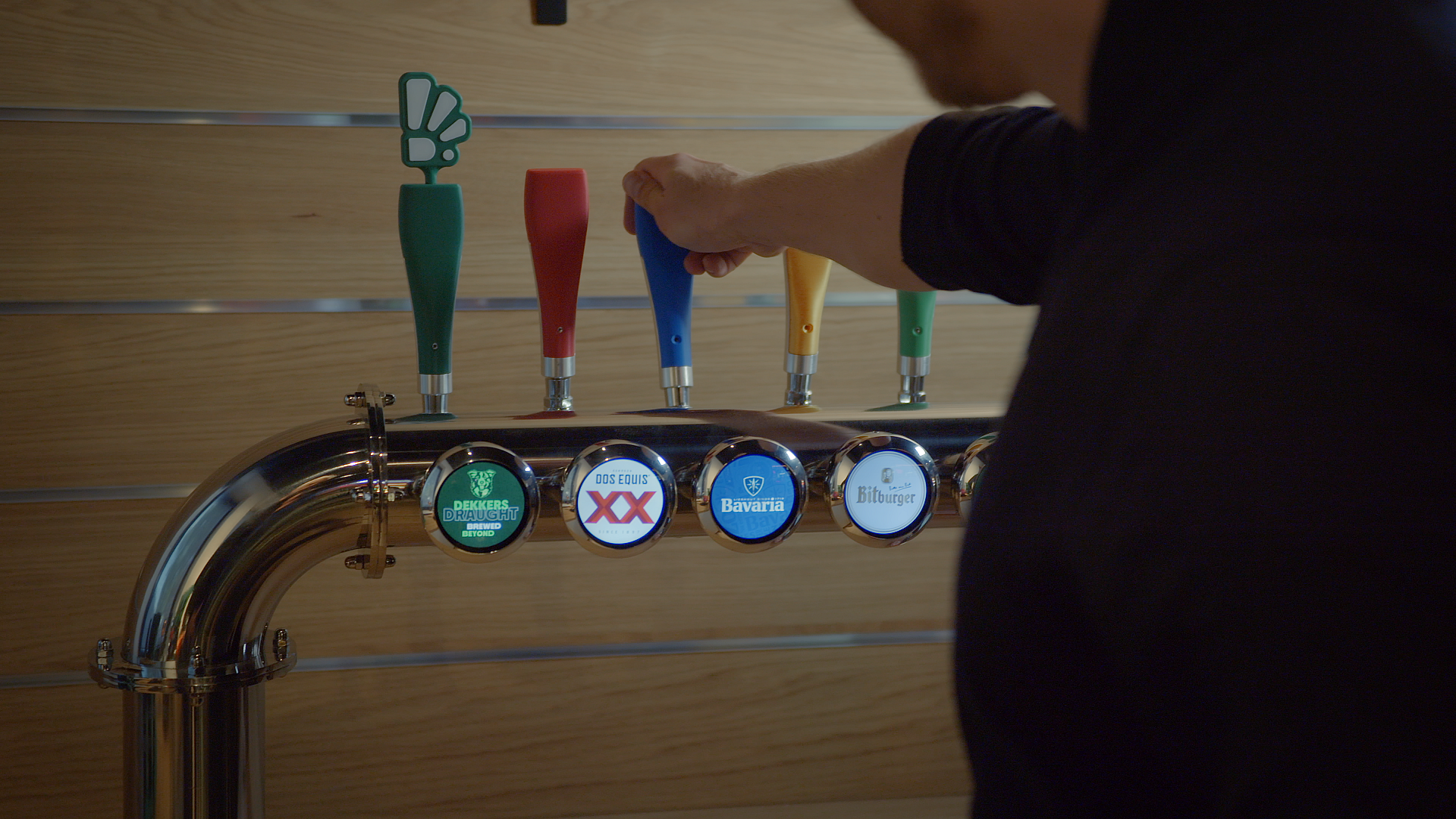Ein Gerät vernetzen: vier praktische Lektionen
Immer mehr Unternehmen vernetzen ihre Produkte. Mit Lattiz, seiner intelligenten Milchlösung, ist FrieslandCampina dabei, dies auch zu tun. Die neue Generation von Lattiz-Maschinen bietet eine Vielzahl von Möglichkeiten, wie z. B. das Ausrollen von Software-Updates aus der Ferne. Was können andere Unternehmen von diesem Projekt lernen?
Lattiz ist eine professionelle Milchschaumlösung für das Gastgewerbe. Mit nur einem Knopfdruck erzeugt Lattiz einen Milchschaum von gleichbleibend hoher Qualität und ermöglicht es den Unternehmern, jedes Mal einen perfekten Kaffee zu servieren, Zeit zu sparen und den Umsatz zu steigern. Das Personal muss die Milch nicht mehr von Hand aufschäumen, was eine große Zeitersparnis bedeutet. Lattiz macht das Aufschäumen von Milch viel einfacher, so dass neue Mitarbeiter schnell in der Lage sein werden, Milchkaffees und Cappuccinos zuzubereiten. Es ist auch möglich, Latte Art zu kreieren, sodass Sie den gleichen luxuriösen, köstlichen Kaffee genießen können, nur einfacher.
Die Innovation von Lattiz liegt in der Kombination aus der Maschine und der speziell entwickelten Milchverpackung. Die Milch wird sehr effizient aufgeschäumt und muss nicht gekühlt werden, wodurch der CO2-Fußabdruck von Lattiz um 20 % geringer ist als bei alternativen Aufschäumverfahren. Darüber hinaus erfüllt Lattiz die höchsten Hygieneanforderungen. Es gibt keinen Kontakt zwischen dem Barista, dem Milchschaum und der Maschine, und die Maschine reinigt sich automatisch.
Der erneuerte Lattiz ist angeschlossen
Die erste Version des Lattiz wurde 2015 eingeführt. Mittlerweile sind in Europa mehr als 10.000 dieser Geräte im Einsatz. Inzwischen ist auch die zweite Generation der Lattiz-Maschinen auf dem Markt. Der neue Lattiz hat sich in mehreren Punkten verbessert. Sie verfügt über einen Touchscreen anstelle von Tasten, ist wesentlich leiser und die Qualität des Milchschaums bleibt über die gesamte Lebensdauer der Maschine konstant. Der neue Lattiz verfügt außerdem über mehr Sensoren und ist wesentlich softwaregesteuerter, sodass Software-Updates wichtiger denn je sind.

Als Lattiz-Projektleiter ist Janneke Tuinte eine der treibenden Kräfte bei der Entwicklung der neuen Maschine. Zusammen mit Niels van der Putten, der für die Entwicklung der vernetzten Seite von Lattiz verantwortlich ist, wirft sie einen Blick zurück auf die Entwicklungsreise. Auf welche Herausforderungen ist das Team gestoßen, und wie können sich andere Unternehmen darauf vorbereiten?
1. Groß denken, aber klein anfangen
"Als wir das Projekt begannen, waren unsere Erwartungen an die Vernetzung von Lattiz sehr hoch", erinnert sich Tuinte. "Zudem gab es mehrere Berater, die sich alle möglichen fantastischen Ideen ausdachten. Das Konzept wurde immer größer und größer, aber es wurde völlig unrealistisch. Am Ende reduzierten wir alles auf einen Fernzugriff für Software-Updates und Einblicke in die Maschinen.“
"Wenn man eine IoT-Lösung mit hochgesteckten Zielen beginnt, wird jeder im Unternehmen große Erwartungen daran knüpfen", fügt Van der Putten hinzu. "Aber sobald das Konzept kleiner und realistischer wird, lässt die Begeisterung nach. Software-Updates sind für das Management nicht sehr attraktiv - es klingt zu sehr nach einem IT-Projekt. Um die interne Unterstützung aufrechtzuerhalten, müsste man so etwas wie eine App entwickeln, nur damit das Projekt 'sexy' bleibt."
Wenn es um Technologie geht, ist es laut Van der Putten wichtig, sowohl kurz- als auch langfristig zu denken. "Man muss eine klare Vorstellung davon haben, wo man hin will, denn die falsche Technologieauswahl schränkt später die Möglichkeiten ein. Aber man muss auch klein anfangen, um die Grundlagen so zu legen, dass das gesamte Ökosystem während des gesamten Prozesses einbezogen werden kann. Deshalb haben wir mit "Over-the-Air"-Software-Updates begonnen. Mit einer wachsenden, vernetzten Flotte von Lattiz-Maschinen können wir dann neue Dienste wie Fernwartung und Fernaktualisierung von Rezepten entwickeln. Diese Entwicklungen werden datengesteuert sein, Kunden und Partner einbeziehen und Schritt für Schritt hinzugefügt werden.
2. Die Vorteile für das Unternehmen greifbar machen
"Am Anfang war das Konzept, das wir entwickelt haben, sehr breit gefächert, woraufhin wir eine Machbarkeitsstudie mit Partnern und Kunden durchgeführt haben", sagt Tuinte. "Dabei stellte sich heraus, dass viele Dinge nicht realistisch waren oder nicht zu den bestehenden Prozessen unserer Partner passten, und so begannen wir mit der Arbeit an einer Roadmap, die eine technologische Grundlage für das Flottenmanagement in Salesforce und 'Over-the-Air'-Software-Updates vorsieht. Dadurch wurden die Vorteile sehr deutlich."
Der Projektleiter betont, dass das Unternehmen direkt von der Möglichkeit profitiert, Updates aus der Ferne auszuführen. "Wir müssen nicht mehr persönlich zu den Maschinen gehen. Früher musste zum Beispiel ein Partner das Update vor Ort mit einem USB-Stick installieren. Das verursacht zusätzliche Kosten, und außerdem ist man in hohem Maße von der Verfügbarkeit der Partner und Kunden abhängig, was die Prozesse vor allem im Ausland verlangsamt. Angesichts der wachsenden Zahl von Maschinen und unserer internationalen Ambitionen ist der Fernzugriff sehr wertvoll."
3. Unterschätzen Sie die Auswirkungen nicht
Ein IoT-Projekt wirkt sich auf alle Arten von Prozessen aus, sowohl innerhalb als auch außerhalb des Unternehmens. "Wenn Sie ein vernetztes Gerät einführen, muss die gesamte Kette folgen", erklärt Tuinte. "Also nicht nur der Hersteller der Maschine und der Softwareentwickler, sondern auch die Servicepartner, die hauptsächlich mechanische Geräte gewohnt sind. Darüber hinaus hatte dieses Projekt einen großen Einfluss auf das Lattiz-Team selbst. Jeder im Unternehmen musste mitmachen, vom Vertrieb über das Marketing bis hin zum Kundendienst."
"Bei der Entwicklung eines vernetzten Geräts geht es nicht nur um das Gerät", sagt Van der Putten. "Es erfordert eine Analyse der gesamten Prozesskette in den Unternehmen, an der jeder beteiligt ist, vom Lieferanten über das Unternehmen selbst bis hin zu Partnern und Kunden. Mit anderen Worten, das gesamte Ökosystem. Es beeinflusst alles, und das schwächste Glied kann das Ergebnis der Reise beeinflussen. Die größte Herausforderung ist daher die organisatorische Koordinierung, das Erreichen eines neuen Niveaus an Professionalität sowohl innerhalb der eigenen Organisation als auch darüber hinaus. Man muss sorgfältig über die Vorteile für die verschiedenen Teile der Organisation und die Partner und Kunden nachdenken, sonst werden sie sich nicht bewegen.
4. Mit einem Experten zusammenarbeiten
Tuinte rät anderen Unternehmen, sich beim Aufbau eines IoT-Projekts mit einem Experten zusammenzutun. "KPN stellt in erster Linie die Simkarten und die IoT-Konnektivität für das neue Lattiz zur Verfügung, und auch die Verwaltung der Simkarten erfolgt über die Plattform von KPN. Aber die Rolle von KPN als objektiver Sparringspartner war für uns noch wertvoller. Am Anfang wussten wir kaum etwas über IoT und KPN konnte uns einen Crashkurs geben. Wir wussten, dass wir jederzeit unsere "vertrauliche Helpline" anrufen konnten, wenn es nötig war.
"Natürlich hat KPN ein kommerzielles Interesse daran, uns zu unterstützen, aber wir konnten wirklich sehen, wie wichtig es für KPN war, dass das Konzept erfolgreich ist", schließt Tuinte. "Sie haben kritisch über inhaltliche Entscheidungen nachgedacht und waren immer bereit, uns zu helfen. Die Tatkraft und Zuverlässigkeit von KPN haben uns wirklich sehr geholfen."




